In mid-February, Metz tied Frédéric Antonetti down to a new deal that is set to see him remain at Stade Saint-Symphorien until June 2024. Club president Bernard Serin spoke in glowing terms about the 59-year-old upon this three-year contract extension being announced, describing the manager, who is in his second stint as Metz boss – the first of which lasted from May 2018 until June 2019 – as “the architect of the last three years” at the Grand Est club.
Perhaps this title is befitting of Antonetti, as while he left his post as manager in the summer of 2019, the Italian remained involved with Les Grenats as the director of football before he returned to the manager’s position back in October. Since Antonetti’s arrival at the club in 2018, Metz achieved promotion from Ligue 2, achieved a 15th-placed finish last season, and now impressively sit in fifth place in Ligue 1, threatening to qualify for Europe.
Les Grenats have got the best defensive record, in terms of goals conceded (26) of any team outside of Ligue 1’s current top-three in the UEFA Champions League places – Lille, PSG and Lyon. Their defensive solidity has played a key role in getting them into their current position, more-so than their attacking output which isn’t quite as impressive. This tactical analysis will explore Antonetti’s defensive tactics at Metz. Our scout report will provide analysis of the key components of Metz’s defensive tactics, why they’ve been so successful this term, while we’ll also highlight some of the big weaknesses in Metz’s defence.
Statistical analysis
Before analysing their shape and providing in-game examples of what this team does off the ball, we’re going to analyse some of the standout defensive statistics, to paint a picture of how this team performs, defensively, in relation to the rest of Ligue 1.
First and foremost, it’s important to note that Metz are not a heavily possession-based side. They’ve retained the third-least possession of any Ligue 1 team this season (44%). Their game plan doesn’t revolve around keeping much of the ball and they don’t tend to press very aggressively in order to regain possession.
Metz have got a PPDA of 15.6 in Ligue 1 for the 2020/21 campaign, which is the seventh-highest PPDA in France’s top-flight at present and higher than the league average of 13.85, meaning that they press less aggressively than the majority of teams in the league.
They don’t have the most passive press in Ligue 1, by any means – they’re pressing intensity is much closer to the average than it is to Montpellier’s PPDA of 20.79 – but they are a relatively passive team off the ball.
So, Metz generally allow the opposition to make plenty of passes before committing a defensive action, but now, we’ll look at how they perform in terms of defensive actions, specifically, defensive duels and interceptions, respectively, in relation to the rest of Ligue 1.
Metz have engaged in the second-most defensive duels (71.97) of any Ligue 1 side this season, while they’ve made the most interceptions (46.28) of any team in Ligue 1 this term.
This may be somewhat surprising, given that they don’t press very aggressively, however, before we look into why they’ve made so many defensive duels and interceptions, we’ll first adjust their stats in these areas, along with the rest of Ligue 1, taking into account their average possession-percentage, in order to get a clearer idea of just how active they are, on average, off the ball, and how much these stats are influenced by the fact that, as we’ve established, Metz are one of Ligue 1’s least possession-based teams.
We’ve divided a base possession percentage of 50% by the average amount of possession that each team in Ligue 1 have conceded this season and multiplied that number by the number of defensive duels and interceptions, respectively, that each Ligue 1 team have made this term to calculate possession adjusted (PAdj) values for their defensive duels and interceptions.
After doing that, we found that Metz rank in 13th place for PAdj defensive duels and ninth place for PAdj interceptions.
So, while they do commit a lot of defensive actions per 90, that is largely due to the fact that they have a lot more opportunities to make them than most other teams in the league due to their non-possession-based tactics. Their average level of activity off the ball, in relation to the rest of Ligue 1, is actually quite middle-of-the-road.
They’re also far more active in terms of making interceptions than they are in terms of engaging in defensive duels, and we’ll look at the reasons for that as we progress deeper into this tactical analysis.
Metz’s pressing
Metz have lined up in several different formations throughout the 2020/21 campaign. From the beginning of the season up until December, they utilised mainly four-at-the-back formations – usually either the 4-1-4-1 or the 4-2-3-1. However, more recently, they’ve been lining up in three/five-at-the-back formations – mainly the 3-4-1-2/5-2-1-2 (depending on the positioning of the wing-backs).
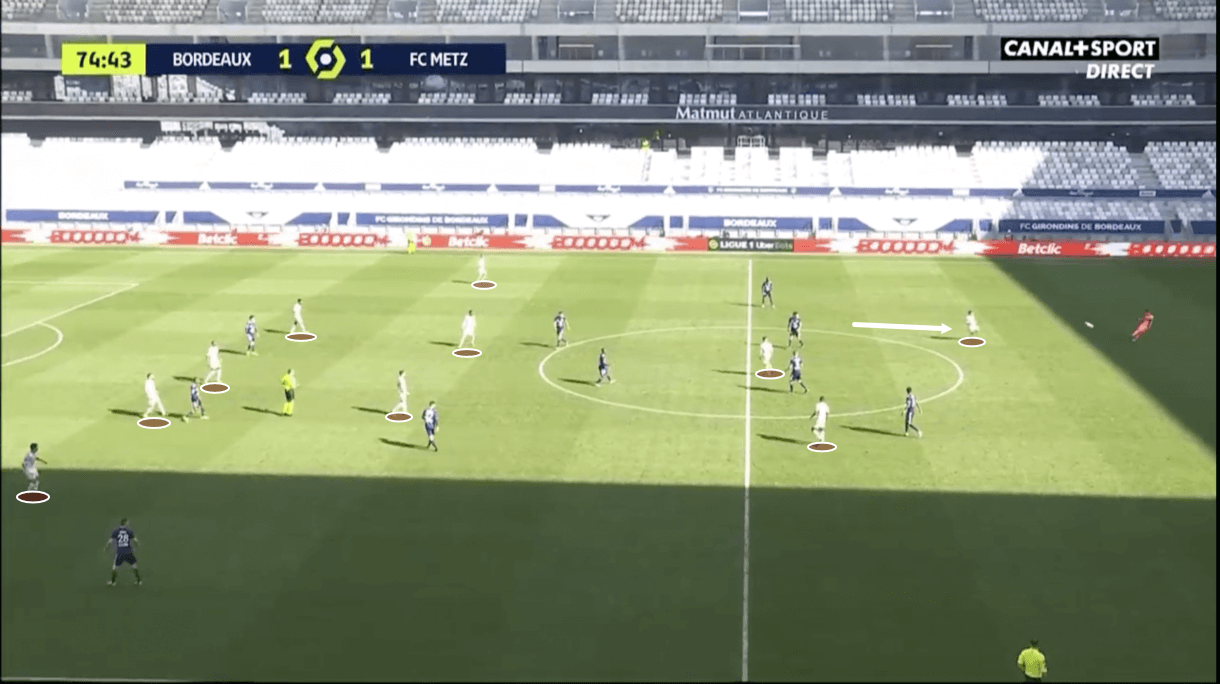
We can see an example of Metz lined up in this shape, while their opponents, Bordeaux on this occasion, are building out from the back in figure 1. Metz are sitting fairly deep here, with their backline retreating and the majority of their players located inside their own half, though one of their attackers can be seen pressing the Bordeaux goalkeeper, Benoît Costil, who is positioned far outside of his box to act as a deep playmaker.
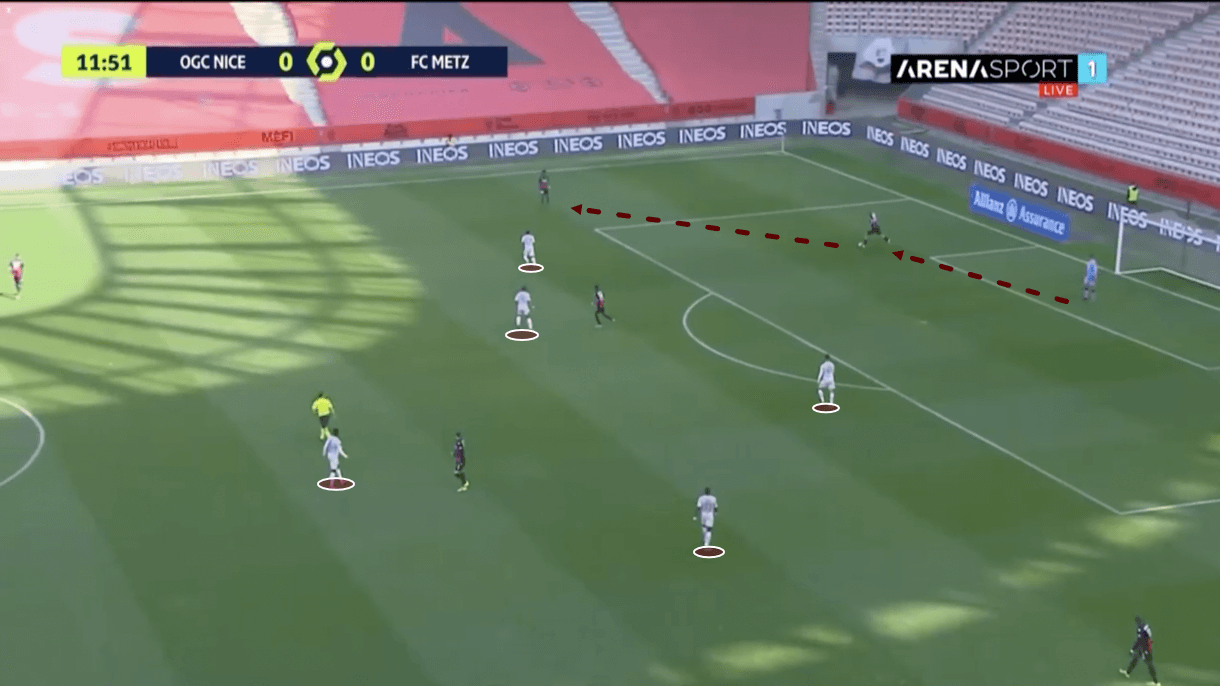
Metz aren’t always located as deep as that, however. From opposition goal-kicks, they actually often tend to position plenty of bodies quite far into the opposition’s half. We can see an example of this in figure 2. Metz utilised a 3-4-3 shape in this game versus Nice, and in this image, we can see their three attackers, as well as both central midfielders, pressing high, with one central midfielder positioned in-line with the front three.
It’s not uncommon to see one of Metz’s central midfielders pressing this high. It often occurs as a result of one of Metz’s attackers vacating an opposition player in order to press higher, leaving one of the other attackers or one of the central midfielders responsible for providing cover, as was the case here for the left central midfielder.
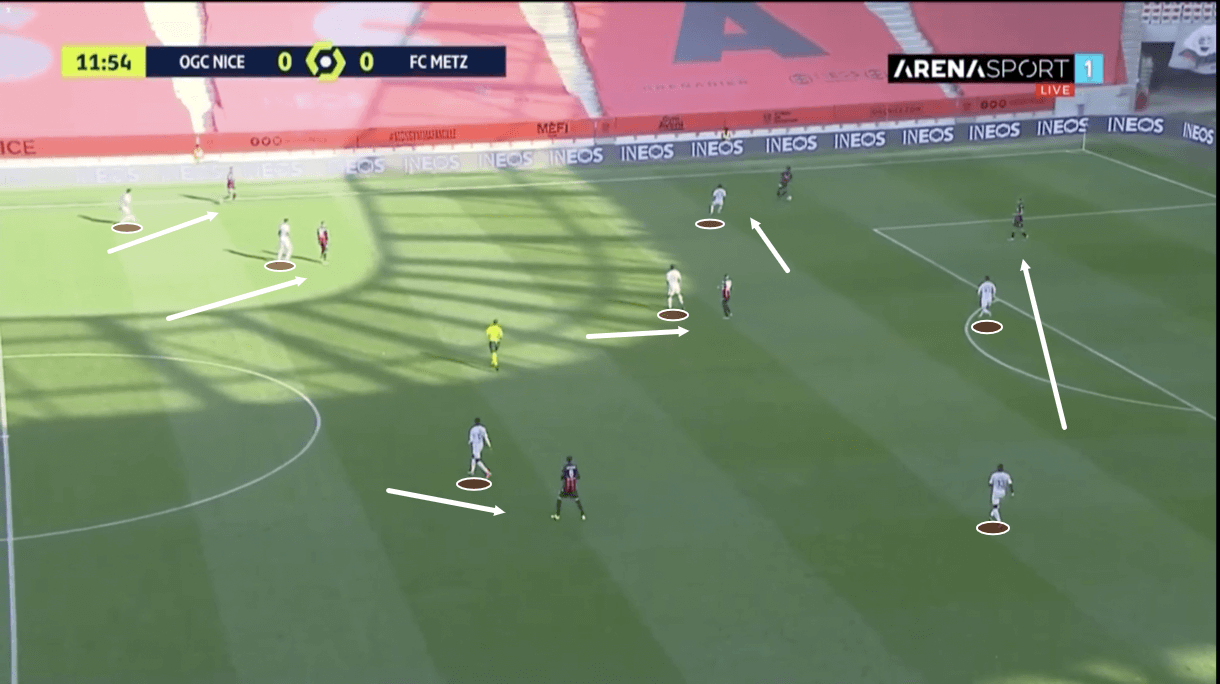
As figure 3 shows, Nice ended up playing the ball out from the goalkeeper to the right centre-back, to the right-back. This triggers Metz’s press to get more aggressive, as the centre-forward, who was positioned closer to Nice’s left centre-back sprints across the box to close down Nice’s right centre-back, in an attempt to block off the right-back’s option of passing the ball back to the right centre-back. Meanwhile, other Metz players also tighten up their marking on the right-back’s nearby passing options and the left-winger closes down the right-back himself.
This is one of the scenarios that Metz like to create in the early stages of the opposition’s build-up play. They like to force the play out wide, where the opposition’s passing options are significantly limited. They then ramp up the aggressiveness of their pressing, attempting to cut off all the nearest passing options.
The desired outcomes from this are 1. The opposition are forced to play the ball long, towards Metz’s centre-backs who are strong in the air or 2. The opposition attempt to play through Metz’s press despite the evident dangers and end up misplacing a pass which allows Metz to counter. Metz generally don’t lunge into tackles in positions like this. They are patient, they create favourable scenarios for themselves and try to force the opposition into mistakes.
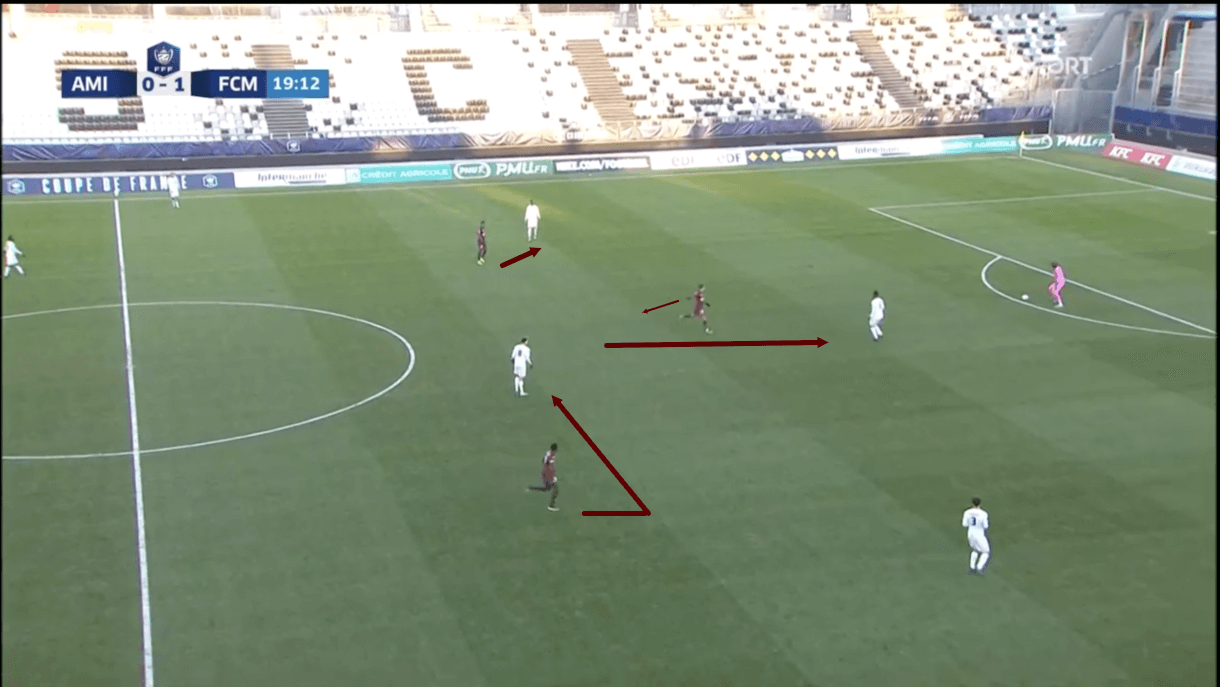
As we mentioned, Metz have usually been defending in a 3-4-1-2 shape of late, as was the case in figure 4 – their 2-1 French Cup win over Amiens last month. When they line up in this shape, their ‘10’ usually marks the opposition’s holding midfielder very closely, assuming they play with a single pivot, at least during the build-up, as Amiens did in this game.
In doing this, Metz are usually able to prevent the opposition from overloading them in central midfield, which is a significant focus of their defensive game. Their centre-backs are also given license to push up into midfield if necessary to prevent Les Grenats from getting overloaded in the centre of the park – they want to avoid this at all costs, where possible, and if ever the opposition opts to play through the midfield, they want to be prepared to win the ball back there too, which is why they try to cut out all possibilities of the opposition creating a free man in midfield.
In figure 4, we can see that Amiens’ holding midfielder is not being marked tightly, and that’s because the ‘10’ has just abandoned him in order to increase pressure on the goalkeeper and left centre-back. However, the ‘10’ can be seen pointing to the holding midfielder, drawing attention to the fact that he is now unmarked, signalling for a teammate to pick him up, which the right forward immediately does. This does leave Ameins’ left-back free, but due to the orientation of the goalkeeper on the ball, the left-back was an unlikely passing option compared to the holding midfielder and the centre-backs, which is why those players were closed down.
As the ‘10’ presses high, the right forward takes his place, leaving Metz in their 3-4-1-2 shape, just with different personnel occupying specific roles. It’s not uncommon to see the ‘10’ act like this within Metz’s system, but if he does, it’s important that someone else fills the void he leaves behind, be that a different attacker or a central midfielder, which provides another example of Antonetti’s side strictly guarding against the opposition creating a free man in midfield.
Metz defending deeper
In terms of their pressing in more advanced areas of the pitch, Metz rely a lot on their organisation to lure the opposition into mistakes. They don’t try to force the mistakes by committing themselves to challenges and risk getting played past. That’s not to say that Metz are entirely risk-averse in terms of their defensive tactics, however. They take calculated risks all over the pitch but the majority of them are made in deeper positions and are set up by the defensive organisation that we analysed in the previous section, which can force the opposition to make risky moves of their own.
Many of Metz’s defensive actions occur in deeper positions, via their holding midfielders, centre-backs and full-backs. In this section, we’ll provide some examples of how these defensive actions occur as a result of Metz’s tactics.

Figure 5 shows us an example of one occasion where Bordeaux managed to play through the centre of the park versus Metz. They didn’t manage to gain numerical superiority over Metz in midfield, but they brought a lot of men deep during the build-up and this paid off in building past the first line and into the midfield. However, as Bordeaux played into midfield, they were forced to play the ball forward quickly with so many Metz shirts around them and due to how many men that they’d positioned deep to get past Metz’s initial press, they didn’t have many men to compete up front.
Metz had an overload inside their half and one of their three centre-backs dashed in front of this forward pass to the striker, intercepted the ball and won back possession for Les Grenats.
This is our first example of Metz’s centre-backs advancing out of the backline and committing to a defensive action. It’s a fairly common site for Antonetti’s side – while he has three centre-backs, they don’t just provide cover for the goalkeeper, unlike those positioned higher up the pitch, they’re very proactive in taking possession back for Metz.
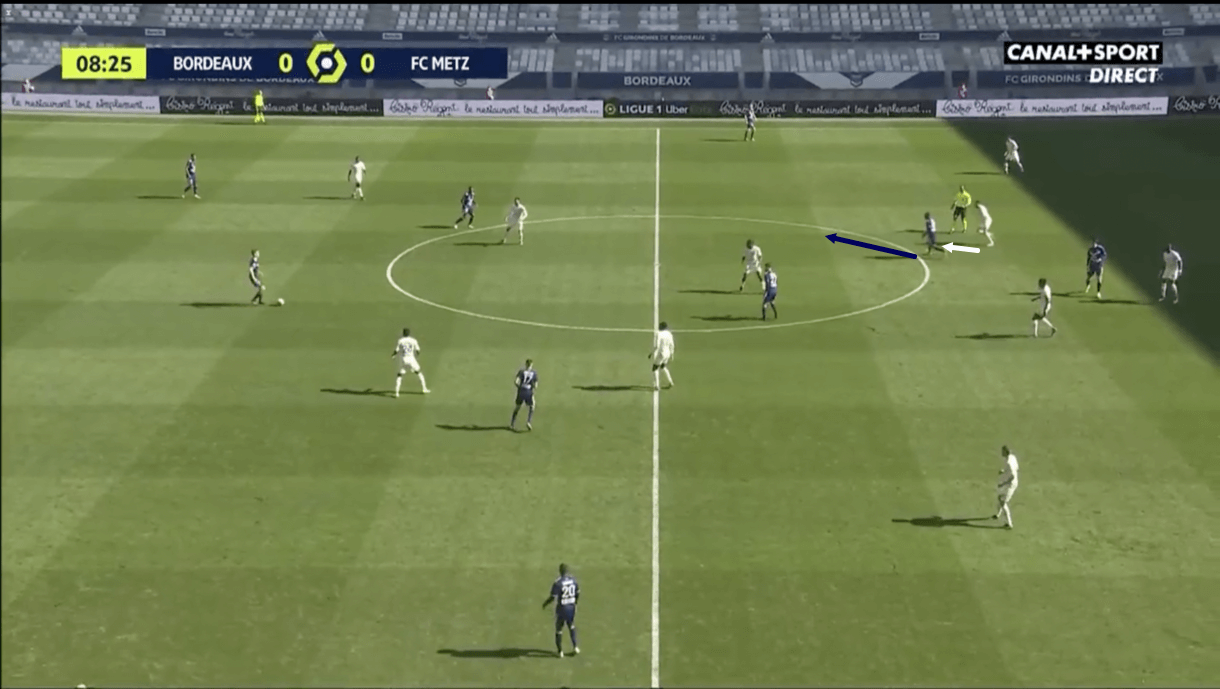
As we mentioned earlier in this tactical analysis, Metz’s centre-backs are given license to push into midfield in order to prevent the opposition from overloading the middle of the park. This is another example of the centre-backs defending very aggressively and we can see an example of this in figure 6.
As the left-sided opposition attacker dropped off into midfield, Metz’s right centre-back followed him, preventing this player from creating a central overload and giving the Bordeaux centre-back on the ball a clear route through midfield. However, this opened up space for Bordeaux’s right forward to attack, and create a long-passing option in behind for the centre-back in possession.
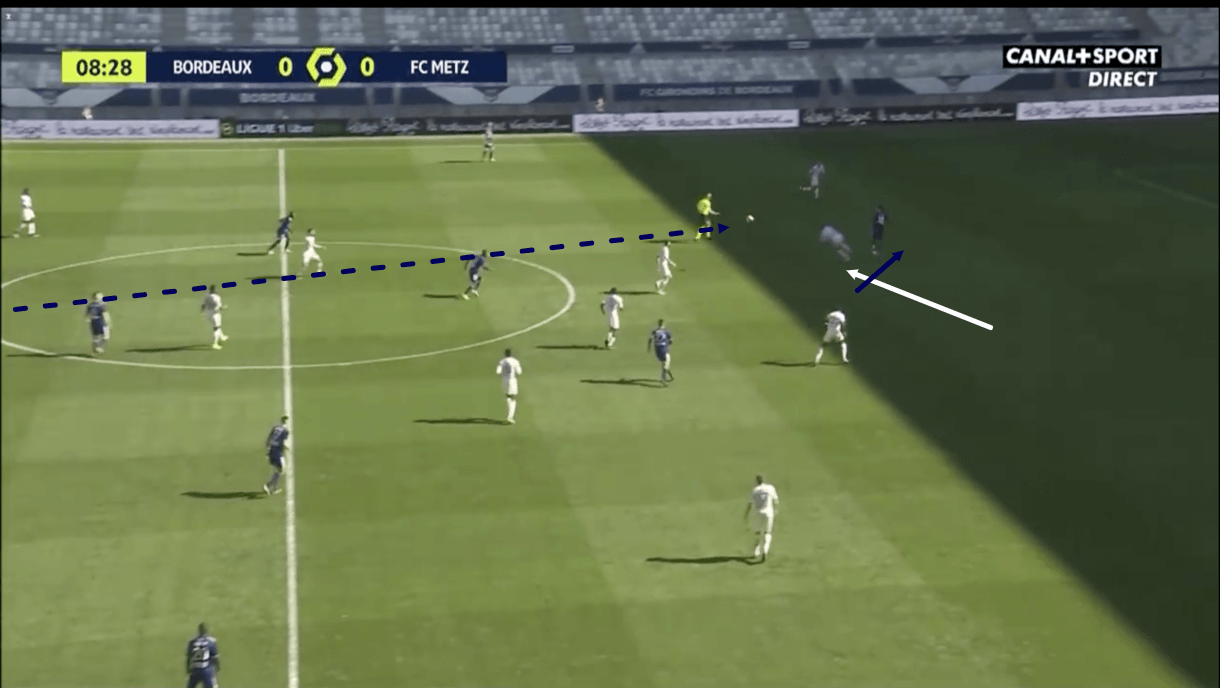
As we can see in figure 7, this is the option that the Bordeaux centre-back chose to take as the play moves on, however, Metz’s middle centre-back was alert to this danger, cut off the passing lane and intercepted the ball via a header, ending this attack and winning back possession for Metz. One benefit for Les Grenats in having three centre-backs is that they often have an overload at the back and so, their centre-backs can provide cover for each other if one gets pulled out of position, as was the case here, with the central centre-back pulling off a key interception.
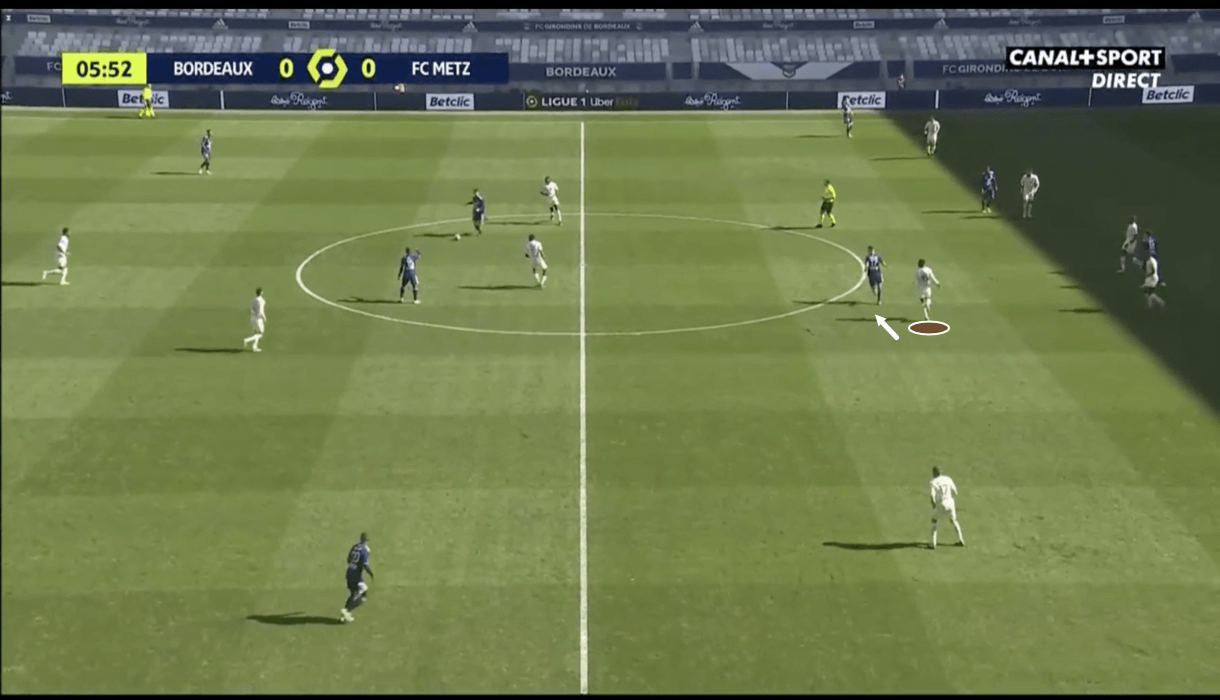
It’s not just Metz’s centre-backs who contribute to their defensive output. As mentioned, their full-backs and central midfielders tend to engage in quite a lot of defensive duels and pull off plenty of interceptions as well, and figure 8 shows us one example of how Metz’s central midfielders tend to operate off the ball.
With Metz’s ‘10’ generally sticking very close to the opposition’s holding midfielder, their two central midfielders also tend to mark the opposition’s more advanced central midfielders tightly, unless they’re required to advance into a higher position to mark a deeper opposition player, in which case a centre-back will likely push into midfield and perform their usual role.
An example of Metz’s central midfielders’ tight marking is seen in figure 8, with the left central midfielder, who is circled.
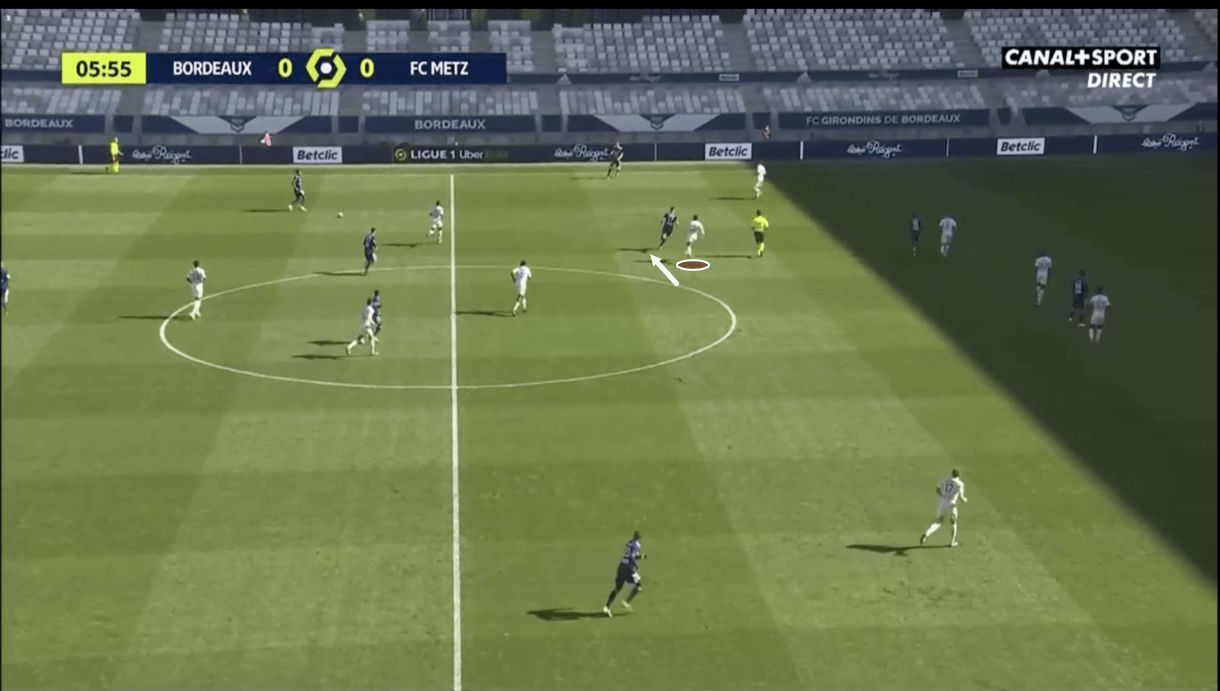
As play moves on, figure 9 shows that this player follows the opposition midfielder all the way over to the right side of central midfield. Earlier on in this tactical analysis, we saw an example of the ‘10’ passing his man off to the right forward, so we know that switching men like this is something that Metz do, however, during the opposition build-up, they don’t really tend to switch men as the opposition player moves across zones, but more-so when they themselves opt to change focus.
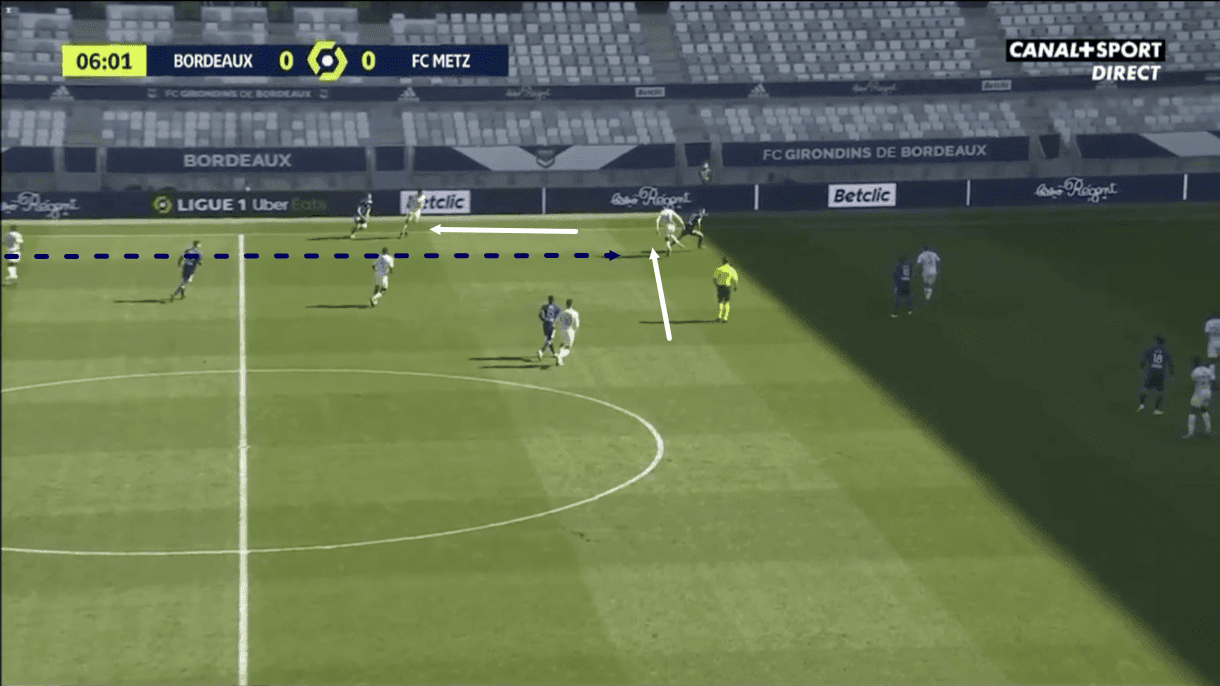
In figure 10, we can see that other Metz players have dropped deep to fill the gap left in midfield by this midfielder, as he has followed his man, and the general play, all the way out to the opposite wing from where we started following him in figure 8.
His defensive work ultimately pays off, as he manages to make the interception here, with the opposition having attempted to play a through ball to the man he followed across the pitch.
This passage of play highlights the value Metz’s central midfielders add to their side’s defensive tactics via their discipline and commitment to Antonetti’s system, as well as the fact that within this system, the central midfielders are often required to mark very tightly.
Metz’s defensive weaknesses
Metz are performing very impressively defensively this season but they aren’t without fault and in this section, we’re going to highlight some areas in which their defending has not quite been as solid as it was in our previous examples.
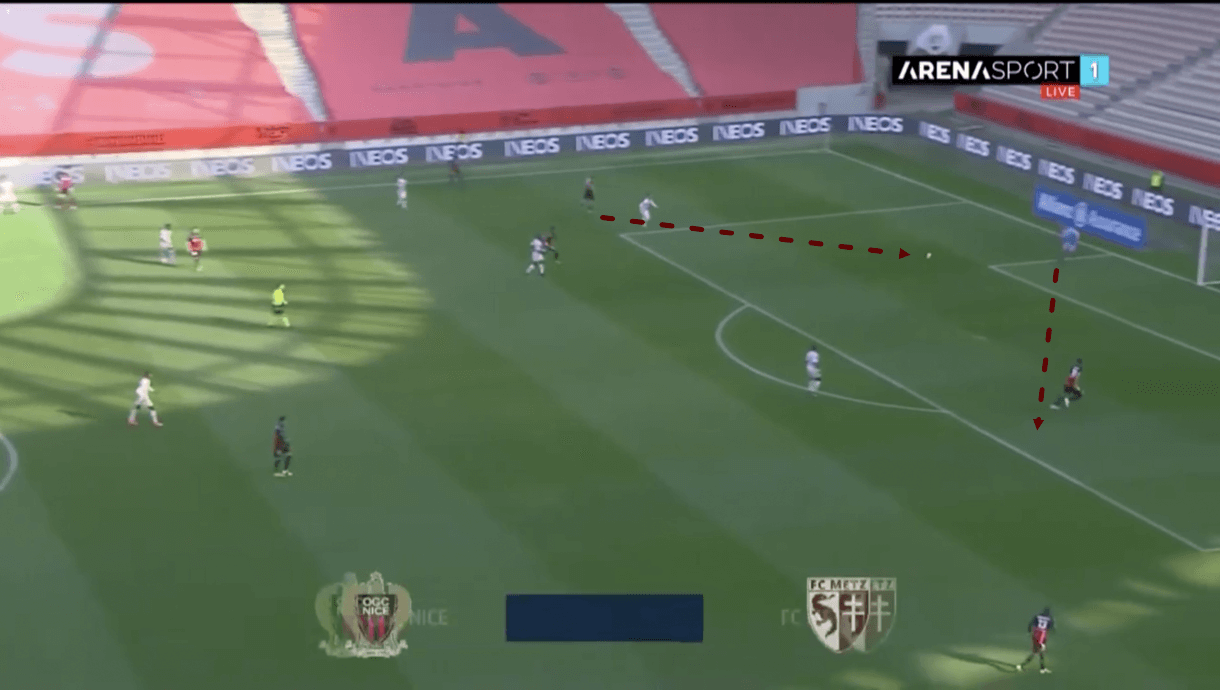
Firstly, we’ll look at the build-up and point out two ways that teams have broken Metz’s press and caused them problems of late. Figure 11 shows us another example from Les Grenats’ recent 2-1 win over Nice, and here, we can see that while Metz covered all the near forward and sideways passing options while pinning the full-back out wide, this Nice player was able to send the ball back to the goalkeeper, who could then quickly switch the play out to the opposite side, where Metz have not got any men at this very moment, due to how many men they committed to the opposite wing.
This highlights the downside to Metz’s pressing tactics. They don’t aggressively press the man on the ball very much and while they attempt to cut off all of the easiest passing options, at times, this player can still find a way out, as was the case here. When the ball escapes from this full-back position and the opposition can switch the play, it can be very dangerous for Metz, due to how many men they committed to that wing and how few men they’ve now got on the opposite wing.
When this happens, they’re required to reorganise themselves very quickly, which they did actually manage to do on this occasion, however, it’s very possible that they won’t always manage to do this, in which case the opposition will likely be able to play past the press and carry the ball upfield.
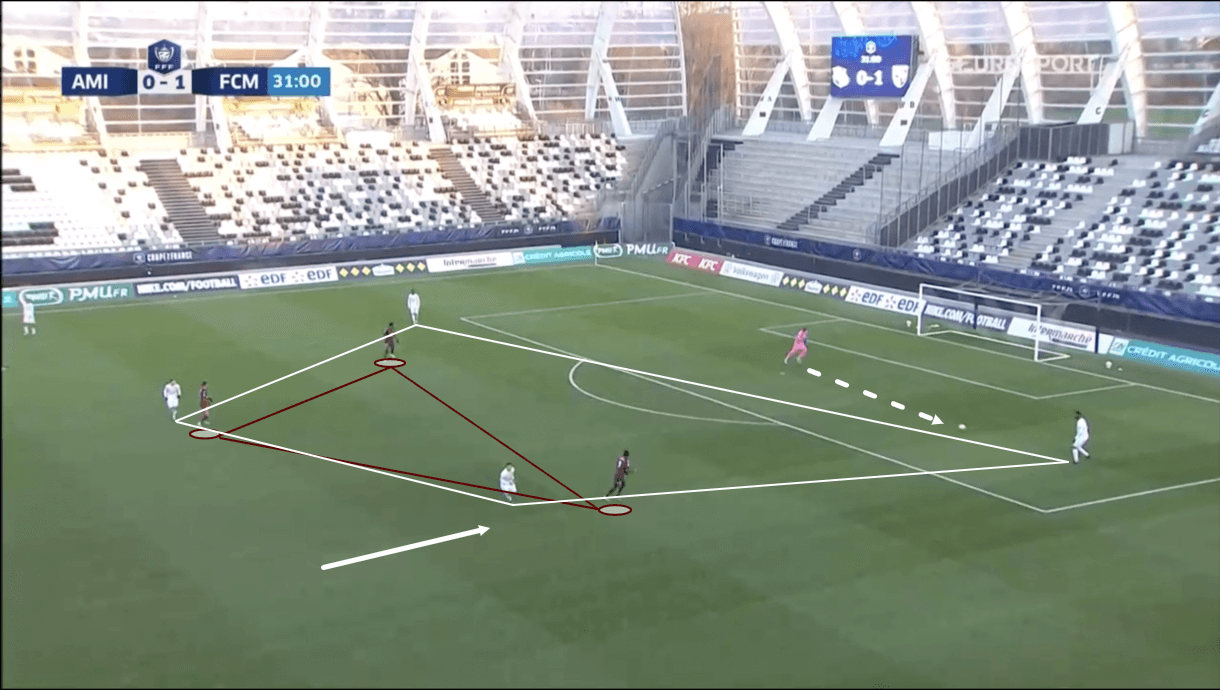
Additionally, while Metz are desperate to prevent the opposition from overloading them in midfield, of course, it’s not always possible to prevent this from happening, and we can see an example of one such occasion where Amiens managed to overload Metz during the build-up in their recent meeting in figure 12.
Here, Amiens essentially doubled-up on Metz’s right forward from the goal-kick before a central midfielder could push up to help provide cover. This made it impossible for the right forward to cover both options. Quick passing and quick off-the-ball movement proved key here and on other occasions where Metz have been caused some problems in the build-up. While they’re an organised defensive unit, it can be difficult to organise well if the opposition play and move quickly enough.
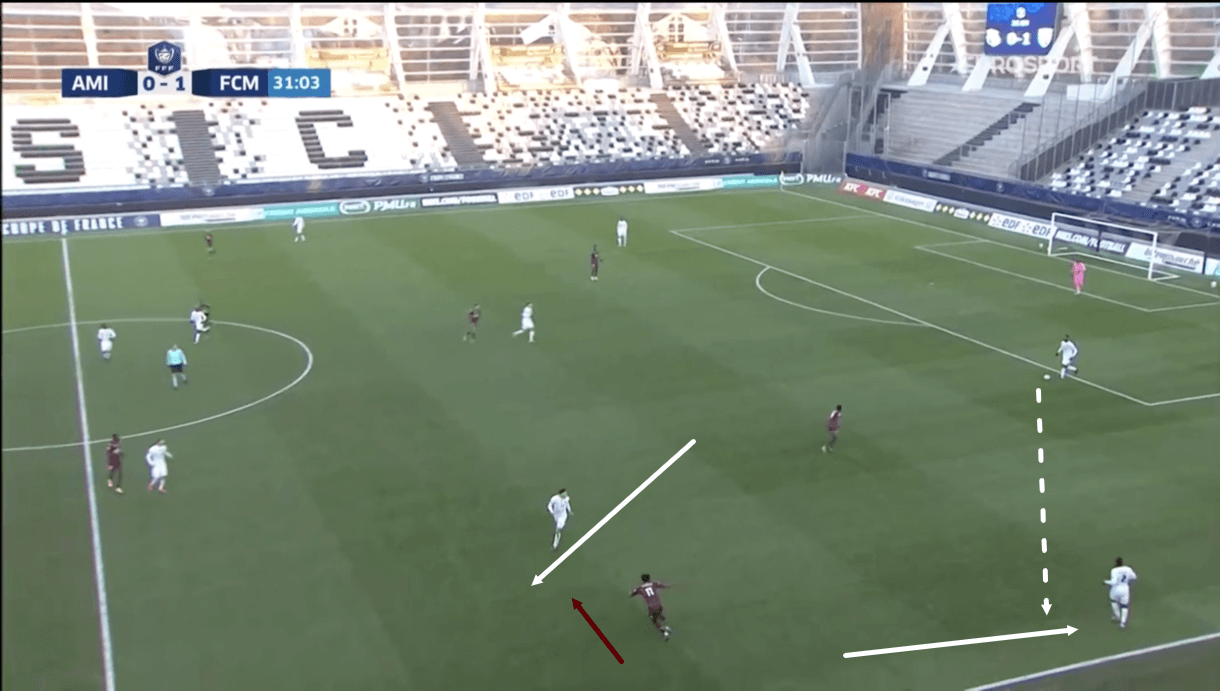
As play moves on, the Amiens player who doubled-up on Metz’s right forward with the left centre-back ends up advancing upfield to double-up on Metz’s right wing-back with the Amiens left-back and this helps Amiens’ left centre-back to progress the ball upfield via a pass. This highlights how just one step of the process going wrong for Metz can cause something of a domino effect, again, provided that the opposition play and move quickly enough.
This also highlights the risk that is involved in Metz’s defensive tactics and how it can come back to bite them on occasion, particularly if they allow the opposition to overload them centrally.
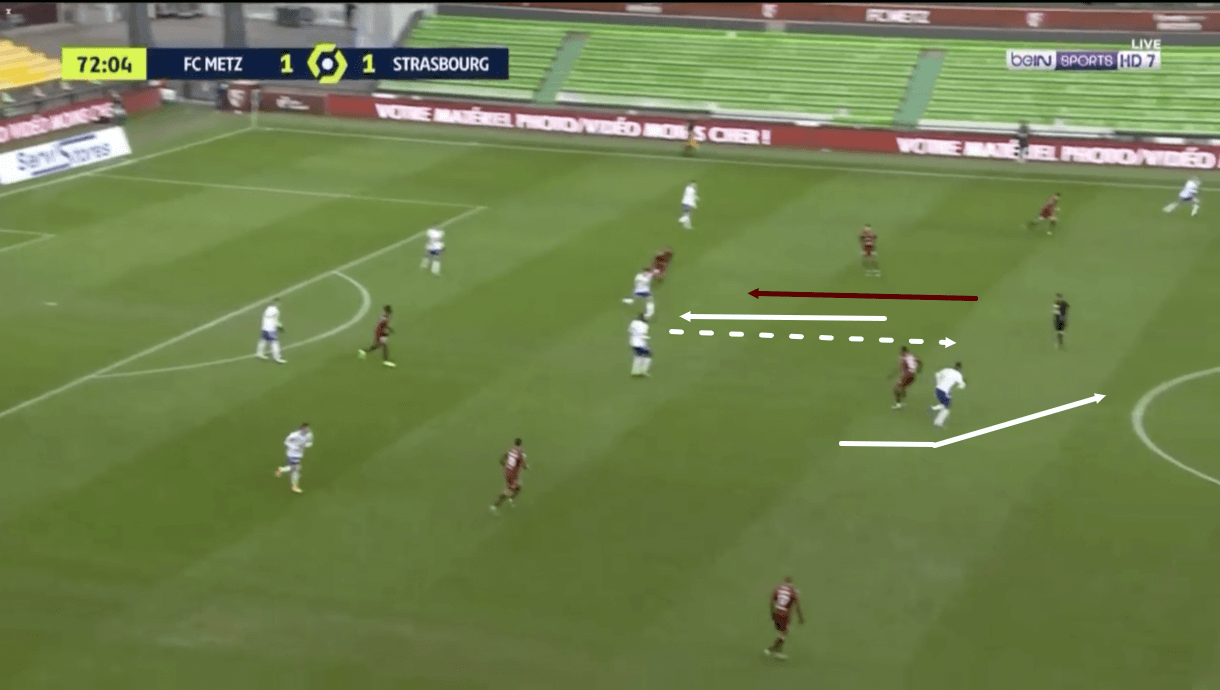
In figure 14, Strasbourg’s central midfielder has dragged Metz’s central midfielder deep and out of position via some intelligent movement, highlighting a downside to how Metz’s central midfielders mark so tightly.
However, as this player turns and lines up a through ball, another major weakness of Metz’s midfielders is on show – their struggles at dealing with blindside runs.
On several occasions this season, both in deeper positions like this, as well as more advanced positions in and just outside of Metz’s penalty area, opposition players have found success with diagonal blindside runs in behind Metz’s central midfielders, as was the case on this occasion being shown here. As play moves on, this player gets onto the end of a through ball and finds himself running straight at Metz’s backline with runners ahead of him – a dangerous situation for Les Grenats resulting from their defensive tactics and this problem of dealing with blindside runs effectively being exploited.
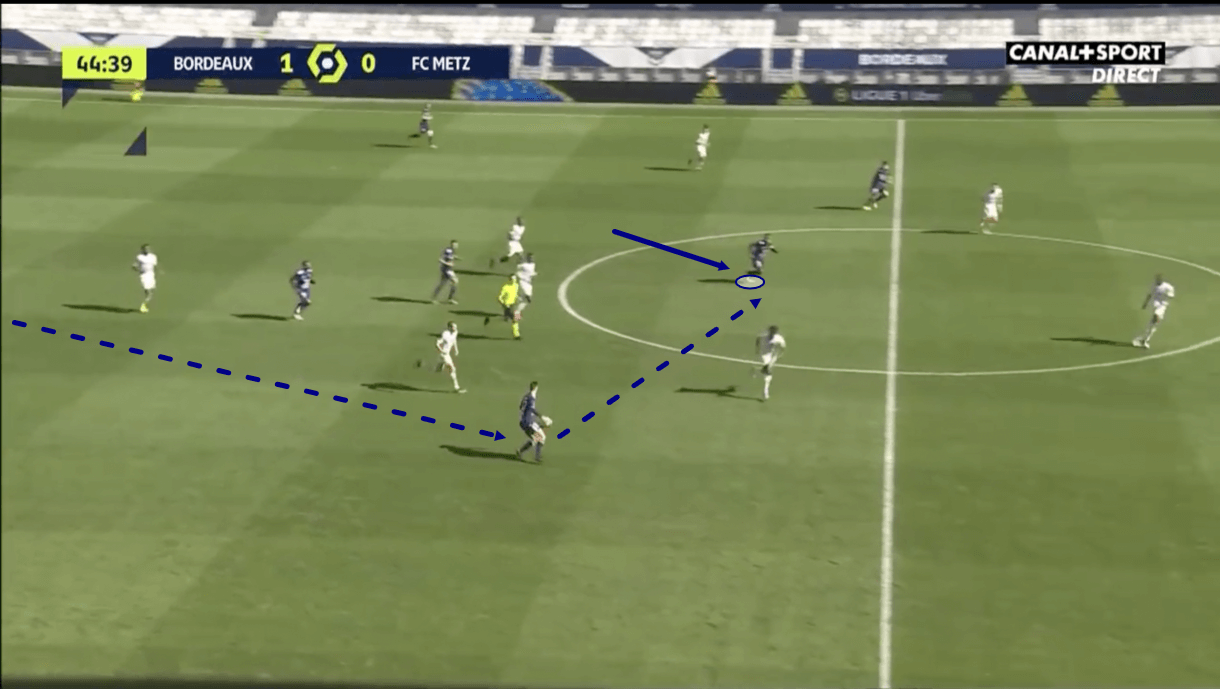
Metz have also displayed vulnerability in transition to defence this season. Their greatest defensive asset is their organisation and discipline. There is a natural absence of this when they’re transitioning to defence, as Antonetti’s chess pieces are not all in the correct places, so this is a prime time for the opposition to strike, which plenty of teams have managed to do this term.
The image above shows us an example of a counter-attack where this Bordeaux player nearest to us got onto the end of a ball from deep and quickly managed to play it into a central attacking player in lots of space in front of Metz’s backline and behind their midfield line. There’s often way too large of a gap between these two lines in transition, which Bordeaux managed to pick up on and exploit.
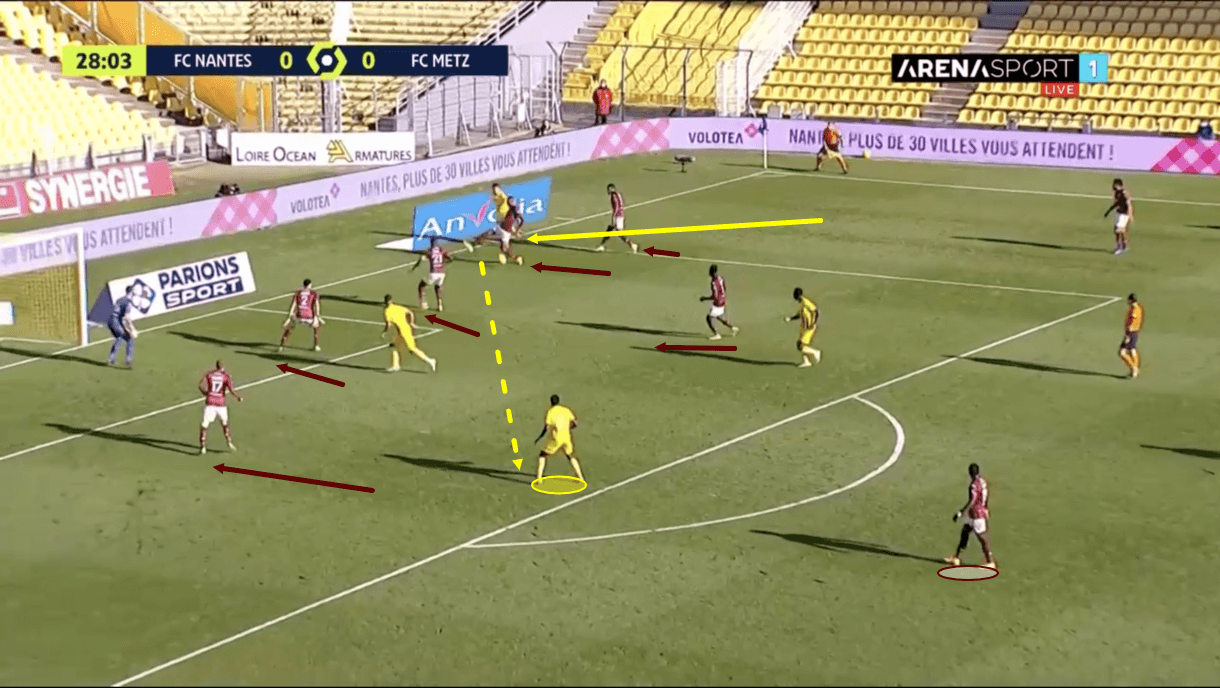
Lastly, Metz’s centre-backs make a lot of blocks, which comes down to how they defend in very deep positions, like this one in figure 15, where they’re inside their own box, with most of their back-five in and around the six-yard box.
There is a downside to defending like this and that is that they often leave players in space on the edge of the area, and when they get onto the end of the ball, Metz’s defenders and goalkeeper are relying on their ability to block the strike, which they’ve been unable to do on several occasions this season, resulting in them conceding several goals from scenarios like this very one.
They are vulnerable to low, cut-back crosses directed towards the edge of the area. The opposition can often find a free man here, provided they advance into a position to make a pass like this in the first place, and it’s clearly a dangerous shooting position.
Conclusion
To conclude our tactical analysis, Metz’s defensive organisation has been key for their solid performances at the back this term. While they’re relatively passive defenders, they take plenty of calculated risks over the pitch and have areas where they actually defend quite aggressively.
They’re a difficult team to play through and break down, and while they’re not without their faults, as we’ve established, it’s evidently been hard for Ligue 1 sides to exploit these mistakes to great effect too often, so while they have faults, their strengths, such as organisation, discipline and intelligent game-reading quality have vastly outweighed them this season, leading to them being in the position that they currently are.





Comments